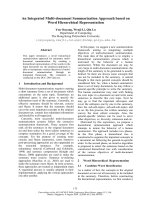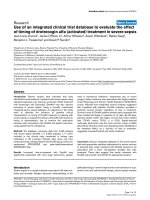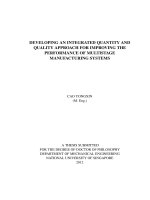Ebook Drug delivery - An integrated clinical and engineering approach: Part 1
Bạn đang xem bản rút gọn của tài liệu. Xem và tải ngay bản đầy đủ của tài liệu tại đây (20.02 MB, 285 trang )
Drug Delivery
An Integrated Clinical
and Engineering Approach
Drug Delivery
An Integrated Clinical
and Engineering Approach
Edited by
Yitzhak Rosen
Pablo Gurman
Noel M. Elman
The material in this book, whether related to medicine or any other topic, should be verified as to its
accuracy, currency, and preciseness by the reader. It should in no way replace any advice given by a medical
professional or any other professional. None of the information provided here should be a substitute for
additional reading, advice, experience, or other relevant information in any topic discussed in this book.
CRC Press
Taylor & Francis Group
6000 Broken Sound Parkway NW, Suite 300
Boca Raton, FL 33487-2742
© 2017 by Taylor & Francis Group, LLC
CRC Press is an imprint of Taylor & Francis Group, an Informa business
No claim to original U.S. Government works
Printed on acid-free paper
Version Date: 20161109
International Standard Book Number-13: 978-1-4665-6594-4 (Hardback)
This book contains information obtained from authentic and highly regarded sources. Reasonable efforts
have been made to publish reliable data and information, but the author and publisher cannot assume
responsibility for the validity of all materials or the consequences of their use. The authors and publishers
have attempted to trace the copyright holders of all material reproduced in this publication and apologize to copyright holders if permission to publish in this form has not been obtained. If any copyright
material has not been acknowledged please write and let us know so we may rectify in any future reprint.
Except as permitted under U.S. Copyright Law, no part of this book may be reprinted, reproduced, transmitted, or utilized in any form by any electronic, mechanical, or other means, now known or hereafter invented, including photocopying, microfilming, and recording, or in any information storage or
retrieval system, without written permission from the publishers.
For permission to photocopy or use material electronically from this work, please access www.copyright
.com ( or contact the Copyright Clearance Center, Inc. (CCC), 222 Rosewood
Drive, Danvers, MA 01923, 978-750-8400. CCC is a not-for-profit organization that provides licenses and
registration for a variety of users. For organizations that have been granted a photocopy license by the
CCC, a separate system of payment has been arranged.
Trademark Notice: Product or corporate names may be trademarks or registered trademarks, and are
used only for identification and explanation without intent to infringe.
Visit the Taylor & Francis Web site at
and the CRC Press Web site at
Contents
Foreword....................................................................................................................ix
Acknowledgments......................................................................................................xi
Editors..................................................................................................................... xiii
Contributors.............................................................................................................. xv
Chapter 1 An Introduction to Key Concepts in Drug Delivery............................. 1
Stephen Kuperberg, Mahyar Pourriahi, Jonathan Daich,
Aaron Richler, Pablo Gurman, Noel M. Elman, and Yitzhak Rosen
Chapter 2 An Introduction to Pharmacokinetics: From Conventional
to Advanced Systemic Drug Delivery Systems.................................. 13
Alan Talevi, Luis Bruno Blanch, and Guillermo R. Castro
Chapter 3 Transporter- and Enzyme-Targeted Prodrugs for Improved Oral
Drug Delivery...................................................................................... 47
Arik Dahan and Shimon Ben-Shabat
Chapter 4 Gastroretentive Delivery: Physicochemical, Biopharmaceutical,
Technological, and Regulatory Considerations................................... 65
Yuvraj Singh, Vivek K. Pawar, Mohini Chaurasia,
and Manish K. Chourasia
Chapter 5 Invasive versus Noninvasive Delivery of Insulin.............................. 101
Sandra Soares, Ana Costa, Pedro Fonte, and Bruno Sarmento
Chapter 6 The Artificial Pancreas..................................................................... 147
Joseph Shivers, Jennifer Lane, Eyal Dassau, and Howard Zisser
Chapter 7 Micro/Nano Devices for Drug Delivery........................................... 181
Roya Sheybani and Ellis Meng
Chapter 8 Microneedle-Mediated Vaccines......................................................207
Ryan F. Donnelly, Maelíosa T. C. McCrudden,
Sharifa Al-Zahrani, and Steven J. Fallows
v
vi
Contents
Chapter 9 Application of Nanoparticle Tracking Analysis in Drug Delivery.... 237
Matthew Wright
Chapter 10 Microsponges for Drug Delivery...................................................... 265
Rishabh Srivastava
Chapter 11 Chitosan for Advancing Drug Delivery............................................ 293
Sanjay K. Jain and Satish Shilpi
Chapter 12 Gene Delivery by Electroporation..................................................... 341
Julie Gehl
Chapter 13 Drug Delivery Systems for Infectious Diseases................................ 349
Maximiliano L. Cacicedo, Germán A. Islan, Pablo Gurman,
and Guillermo R. Castro
Chapter 14 Nanotechnology in Drug Delivery to Chronic Inflammatory
Diseases............................................................................................. 373
Mazen M. El-Hammadi and José L. Arias
Chapter 15 Intrathecal Drug Delivery................................................................. 401
SriKrishna Chandran
Chapter 16 Cancer Stem Cell Drug Delivery...................................................... 411
Masturah Bte Mohd Abdul Rashid, Lissa Nurrul Abdullah,
Tan Boon Toh, and Edward Kai-Hua Chow
Chapter 17 Cardiac Drug Delivery...................................................................... 439
Paula Díaz-Herráez, Simón Pascual-Gil de Gómez,
Elisa Garbayo, Teresa Simón-Yarza, Felipe Prósper,
and María J. Blanco-Prieto
Chapter 18 Current Developments in Nanotherapeutics for Airway Diseases.... 481
Indrajit Roy, Ridhima Juneja, Komal Sethi, and Neeraj Vij
vii
Contents
Chapter 19 Intravitreal Drug Delivery................................................................. 495
Omar Saleh, Mark Ihnen, and Shlomit Schaal
Chapter 20 Drug Delivery in Obstetrics and Gynecology................................... 531
David Shveiky, Yael Hants, and Sarit Helman
Chapter 21 Drug Delivery Systems: A Regulatory Perspective.......................... 549
Pablo Gurman, Noel M. Elman, and Yitzhak Rosen
Index....................................................................................................................... 573
Foreword
This book is a comprehensive overview in the much needed area of drug delivery.
It addresses a critical unmet need, the approach of integrating the clinical and engineering disciplines for drug delivery optimization and advancement. This integration is a must, requires a patient-oriented approach, and is a key foundation in drug
delivery development.
Furthermore, the book focuses on important advances and discusses how an integrated approach was used for these advances. It consists of 21 chapters, starting
with a thorough introduction to drug delivery and pharmacokinetics, followed by
diverse clinical examples of this integration. The book discusses the following areas
and their advances: oral and intrathecal drug delivery; insulin delivery and artificial
pancreas; micro- and nanotechnology for drug delivery, including applications of
micro- and nanotechnology in vaccines; inflammatory diseases; airway diseases and
the use of nanoparticles as tracking systems; biomaterial-based delivery systems,
including chitosan and microsponges; gene delivery, cancer drug delivery with a
focus on stem cells; cardiac drug delivery; intravitreal drug delivery; and drug delivery in obstetrics and gynecology as well as an important chapter on FDA regulation
of drug delivery systems.
As an experienced clinician and discoverer of a new autoimmune syndrome
(ASIA Syndrome), developer of novel therapeutics, publisher of numerous papers
and books, and editor in chief of two journals on autoimmunity (Autoimmunity
Reviews IF-7.95 and Journal of Autoimmunity IF 8.4), it is my hope that all clinicians
and engineers involved in advancing drug delivery will find in this book a useful
resource. Therefore, I give this book the highest recommendation.
Yehuda Shoenfeld, MD, FRCP, MaACR
Head of Zabludowicz Center for Autoimmune Diseases
Sheba Medical Center, Affiliated with Tel Aviv University
ix
Acknowledgments
We, as editors, take this opportunity to acknowledge all the contributors, editorial
staff, family, and friends for greatly assisting us in making this important book publication a reality.
xi
Editors
Yitzhak Rosen, MD, is a graduate of the Tel Aviv University
of Medicine. He completed an internal medicine residency
at Coney Island Hospital and is currently a fellow at the
Cardiovascular Division of SUNY Downstate Medical Center
in Brooklyn, New York. He has worked as a research scientist
at the Institute for Soldier Nanotechnologies, Massachusetts
Institute of Technology (MIT). He is also the president and
CEO of Superior NanoBioSystems LLC, a biomedical company. He has served in the Israel Defense Forces (IDF) as a medical officer and
physician in militarily active areas. He completed a medical internship at the Rabin
Medical Center and has worked at the Oncology Institutes of both the Rabin and
the Sheba Medical Centers in Israel. He has invented a microfluidic chip platform,
funded by the Defense Advanced Research Projects Agency (DARPA), for effecting
extremely rapid blood typing and cross-matching for mass casualties in collaboration
with the MEMS and Nanotechnology Exchange. In addition, he is the inventor of
several medical ultrasound technologies.
Pablo Gurman, MD, earned his MD degree from Buenos
Aires University School of Medicine in 2002, where he worked
at the Pharmacology Department for 10 years. He is currently
the chief medical officer at GearJump Technologies, a biotechnology company dedicated to developing innovative solutions
to public health problems. Prior to this appointment, he was
a research scientist at the Materials Science and Engineering
Department at the University of Texas-Dallas, as well as a
research collaborator at Dr. Elman’s group at the Institute for
Soldiers Nanotechnologies at the Massachusetts Institute of
Technology (MIT). Dr. Gurman was a visiting scientist at
Argonne National Laboratory, where he worked under the artificial retina program.
Gurman’s primary research interests involve micro- and nanotechnology for medical diagnostics and therapeutics, controlled release technologies, and biomaterials.
Noel M. Elman, PhD, is the CEO and founder of GearJump
Technologies, LLC, a company dedicated to development
of biotechnological solutions for public health applications.
Dr. Elman is also a lecturer in technology and innovation
at the Buenos Aires Institute of Technology. He worked at
Draper Laboratory, an MIT-affiliated DoD-supported R&D
center, where he was an appointed distinguished member
of the technical staff. Prior to this appointment, he was a
research scientist and principal investigator at the Institute
for Soldier Nanotechnologies at MIT, leading a translational research group
xiii
xiv
Editors
focused on developing technologies for biotech, biomed, and public health applications. In addition, he was appointed an Innovation Fellow at Massachusetts
General Hospital. Dr. Elman’s research focus is on rapid translation from idea
conceptualization to experimental realization. He earned his bachelor’s and master’s degrees in electrical engineering at Cornell University, and his PhD degree
in electrical engineering at Tel Aviv University. He performed postdoctoral studies at MIT, investigating several micro- and nanodevices for therapeutics and
diagnostics.
Contributors
Lissa Nurrul Abdullah
Cancer Science Institute of Singapore
National University of Singapore
Singapore
Sharifa Al-Zahrani
School of Pharmacy
Queen’s University
Belfast, United Kingdom
José L. Arias
Department of Pharmacy and
Pharmaceutical Technology
Faculty of Pharmacy
University of Granada
Campus Universitario de Cartuja s/n
Granada, Spain
Shimon Ben-Shabat
Department of Clinical Pharmacology
School of Pharmacy
Faculty of Health Sciences
Ben-Gurion University of the Negev
Beer-Sheva, Israel
Luis Bruno Blanch
Medicinal Chemistry
Department of Biological Sciences
School of Sciences
National University of La Plata (UNLP)
La Plata, Argentina
María J. Blanco-Prieto
Department of Pharmacy and
Pharmaceutical Technology
School of Pharmacy
University of Navarra
Pamplona, Spain
Maximiliano L. Cacicedo
Nanobiomaterials Laboratory
Institute of Applied Biotechnology
(CINDEFI, UNLP-CONICET-CCT
La Plata)
Department of Chemistry
School of Sciences
Universidad Nacional de La Plata
La Plata, Argentina
Guillermo R. Castro
Nanobiomaterials Laboratory
Institute of Applied Biotechnology
(CINDEFI, UNLP-CONICET-CCT
La Plata)
Department of Chemistry
School of Sciences
National University of La Plata
La Plata, Argentina
SriKrishna Chandran
University Hospitals of Cleveland
Cleveland, Ohio
Mohini Chaurasia
Amity Institute of Pharmacy
Amity University
Lucknow, India
Manish K. Chourasia
Pharmaceutics Division
CSIR-Central Drug Research Institute
Lucknow, India
Edward Kai-Hua Chow
Department of Pharmacology
Yong Loo Lin School of Medicine
and
Cancer Science Institute of Singapore
National University of Singapore
Singapore
xv
xvi
Contributors
Ana Costa
CESPU
Instituto de Investigação e Formação
Avançada em Ciências e Tecnologias
da Saúde
Department of Pharmaceutical Sciences
Gandra-PRD, Portugal
Mazen M. El-Hammadi
Department of Pharmacy and
Pharmaceutical Technology
Faculty of Pharmacy
University of Granada
Campus Universitario de Cartuja s/n
Granada, Spain
Arik Dahan
Department of Clinical Pharmacology
School of Pharmacy
Faculty of Health Sciences
Ben-Gurion University of the Negev
Beer-Sheva, Israel
and
Jonathan Daich
Superior NanoBioSystems LLC
Eyal Dassau
Harvard John A. Paulson School of
Engineering and Applied Sciences
Harvard University
Cambridge, Massachusetts
Simón Pascual-Gil de Gómez
Department of Pharmacy and
Pharmaceutical Technology
School of Pharmacy
University of Navarra
Pamplona, Spain
Paula Díaz-Herráez
Department of Pharmacy and
Pharmaceutical Technology
School of Pharmacy
University of Navarra
Pamplona, Spain
Ryan F. Donnelly
School of Pharmacy
Queen’s University
Belfast, United Kingdom
Department of Pharmaceutics and
Pharmaceutical Technology
Faculty of Pharmacy
Damascus University
Damascus, Syria
Noel M. Elman
GearJump Technologies, LLC
Brookline, Massachusetts
Steven J. Fallows
School of Pharmacy
Queen’s University
Belfast, United Kingdom
Pedro Fonte
CESPU
Instituto de Investigação e Formação
Avançada em Ciências e Tecnologias
da Saúde
Department of Pharmaceutical Sciences
Gandra-PRD, Portugal
and
REQUIMTE
Department of Chemistry
University of Porto
Porto, Portugal
Elisa Garbayo
Department of Pharmacy and
Pharmaceutical Technology
School of Pharmacy
University of Navarra
Pamplona, Spain
xvii
Contributors
Julie Gehl
Department of Oncology
C*EDGE (Center for Experimental
Drug and Gene Electrotransfer)
Copenhagen University Hospital
Herlev, Denmark
Pablo Gurman
Gur&Gor LLC
Revere, Massachusetts
Yael Hants
Department of Obstetrics and
Gynecology
Hadassah–Hebrew University Medical
Center, Ein Kerem
Jerusalem, Israel
Sarit Helman
Department of Obstetrics and
Gynecology
Shaare Zedek Medical Center
Jerusalem, Israel
Mark Ihnen
Kentucky Eye Care
Louisville, Kentucky
Germán A. Islan
Nanobiomaterials Laboratory
Institute of Applied Biotechnology
(CINDEFI, UNLP-CONICET-CCT
La Plata)
Department of Chemistry
School of Sciences
Universidad Nacional de La Plata
La Plata, Argentina
Sanjay K. Jain
Pharmaceutics Research Project
Laboratory
Department of Pharmaceutics
Dr. Hari Singh Gour University
Sagar, Madhya Pradesh, India
Ridhima Juneja
Department of Chemistry
University of Delhi
Delhi, India
Stephen Kuperberg
SUNY Downstate Medical Center
Department of Critical Care and
Pulmonary Medicine
Brooklyn, New York
Jennifer Lane
Drexel University College of Medicine
Philadelphia, Pennsylvania
Maelíosa T. C. McCrudden
School of Pharmacy
Queen’s University
Belfast, United Kingdom
Ellis Meng
Department of Biomedical Engineering
Ming Hsieh Department of Electrical
Engineering
University of Southern California
Los Angeles, California
Vivek K. Pawar
Pharmaceutics Division
CSIR-Central Drug Research Institute
Lucknow, India
Mahyar Pourriahi
SUNY Downstate Medical Center
Department of Medicine
Brooklyn, New York
Felipe Prósper
Hematology, Cardiology and Cell
Therapy
Clínica Universidad de Navarra and
Foundation for Applied Medical
Research
University of Navarra
Pamplona, Spain
xviii
Masturah Bte Mohd Abdul Rashid
Department of Pharmacology
Yong Loo Lin School of Medicine
National University of Singapore
Singapore
Aaron Richler
Brookdale University Hospital
Brooklyn, New York
Yitzhak Rosen
SUNY Downstate Medical Center
Department of Medicine,
Cardiovascular Division
Brooklyn, New York
Contributors
Shlomit Schaal
Department of Ophthalmology and
Visual Sciences
University of Massachusetts Medical
School
Worcester, Massachusetts
Komal Sethi
Department of Chemistry
University of Delhi
Delhi, India
Roya Sheybani
Department of Biomedical Engineering
University of Southern California
Los Angeles, California
and
Superior NanoBioSystems LLC
New Jersey
Indrajit Roy
Department of Chemistry
University of Delhi
Delhi, India
Omar Saleh
Department of Ophthalmology
Jordan University of Science and
Technology
Irbid, Jordan
Bruno Sarmento
CESPU
Instituto de Investigação e Formação
Avançada em Ciências e Tecnologias
da Saúde
Department of Pharmaceutical Sciences
Gandra-PRD, Portugal
and
INEB
Institute of Biomedical Engineering
University of Porto
Porto, Portugal
Satish Shilpi
Pharmaceutics Research Project
Laboratory
Department of Pharmaceutical Sciences
Dr. Hari Singh Gour University
Sagar, Madhya Pradesh, India
and
Department of Pharmaceutics
Ravishankar College of Pharmacy
Bhopal, Madhya Pradesh, India
Joseph Shivers
Columbia University College of
Physicians and Surgeons
New York, New York
David Shveiky
Department of Obstetrics and
Gynecology
Hadassah–Hebrew University Medical
Center, Ein Kerem
Jerusalem, Israel
xix
Contributors
Teresa Simón-Yarza
Department of Pharmacy and
Pharmaceutical Technology
School of Pharmacy
University of Navarra
Pamplona, Spain
Yuvraj Singh
Pharmaceutics Division
CSIR-Central Drug Research Institute
Lucknow, India
Sandra Soares
CESPU
Instituto de Investigação e Formação
Avançada em Ciências e Tecnologias
da Saúde
Department of Pharmaceutical Sciences
Gandra-PRD, Portugal
Rishabh Srivastava
Department of Pharmaceutics
Rajiv Academy for Pharmacy
Mathura, India
Alan Talevi
Biopharmacy
Department of Biological Sciences
School of Sciences
National University of La Plata (UNLP)
CCT La Plata CONICET
La Plata, Argentina
Tan Boon Toh
Cancer Science Institute of Singapore
National University of Singapore
Singapore
Neeraj Vij
Department of Pediatric Respiratory
Science
The Johns Hopkins University School
of Medicine
Baltimore, Maryland
and
College of Medicine
Central Michigan University
Mt Pleasant, Michigan
Matthew Wright
Nanosight Ltd.
Wiltshire, United Kingdom
Howard Zisser
Dept. of Chemical Engineering
University of California, Santa Barbara
Santa Barbara, California
1
An Introduction
to Key Concepts
in Drug Delivery
Stephen Kuperberg, Mahyar Pourriahi,
Jonathan Daich, Aaron Richler, Pablo Gurman,
Noel M. Elman, and Yitzhak Rosen
CONTENTS
Overview.....................................................................................................................2
Drug Delivery: Routes of Administration................................................................... 2
Oral Route..............................................................................................................2
Sublingual Route....................................................................................................3
Rectal Route...........................................................................................................3
Parenteral Routes...................................................................................................3
Miscellaneous Routes............................................................................................ 3
Drug Elimination....................................................................................................4
Key Concepts in Pharmacodynamics.......................................................................... 4
Therapeutic Window..............................................................................................4
Drug Delivery Systems: Pharmaceutical Systems versus Drug Delivery Devices..... 4
Drug Delivery Systems: Clinical Applications........................................................... 5
Diabetes and Insulin Delivery Systems.................................................................. 5
Cancer and Antineoplastic Drug Delivery Systems............................................... 6
Epilepsy and Benzodiazepines Drug Delivery Systems........................................ 7
Other Examples of Drug Delivery Systems................................................................ 8
Novel Approaches in Drug Delivery........................................................................... 8
Gene Delivery: DNA and RNA as Payloads for Drug Delivery............................ 8
Cell Delivery..........................................................................................................8
Novel Targets in Drug Delivery: Cancer Stem Cell Delivery..................................... 8
Novel Delivery Modalities Based on the Carrier: Micro and Nanosystems.......... 9
Summary..................................................................................................................... 9
References................................................................................................................. 10
1
2
Drug Delivery
OVERVIEW
Drug delivery is a broad and active area of research involving a multidisciplinary
approach whose integrative aim is to assist in reaching the optimization of drug
efficacy by effective delivery of the active drug component to its target tissue
while minimizing toxicity. The purpose of this chapter in particular and the book
as a whole is to address clinical and engineering integration approaches for drug
delivery systems. The clinical aspect involves understanding the unmet need and
the clinical implications involved. It also requires understanding the individual
clinical and biological differences of patients. Moreover, generating clinical and
biological data is critical for drug delivery as this data can delineate the optimized pathway for a particular drug and its delivery system. In addition, pathophysiology of disease can affect drug delivery; for example, inflammation may
greatly alter the disposition of a medication, thereby modifying its efficacy, such
as drug penetration to a particular tissue [1–3]. The engineering aspect, on the
other hand, involves either the manipulation of the physicochemical properties of
the active ingredient or formulation (pharmaceutical engineering) or the fabrication of devices based on mechanical engineering principles in order to achieve a
desired pharmacokinetic–pharmacodynamics profile of the active principle (drug
delivery devices).
Integration of clinical and engineering principles involves a constant interaction
between these two disciplines, and therefore, this book is intended for both the drug
delivery engineer and the clinician. This chapter briefly discusses the rudimentary
foundations of pharmacology that must be considered when designing drug delivery
systems and provides clinical examples where drug delivery systems are playing a
critical role. In addition, a brief description of novel approaches in drug delivery will
be described to illustrate the fast development of this field.
DRUG DELIVERY: ROUTES OF ADMINISTRATION
There are numerous routes of drug delivery with enteral and parenteral being the
most common. Enteral routes of drug administration can include oral, sublingual, or
rectal. Parenteral routes include injections, such as intravenous, intramuscular, and
subcutaneous. The routes of drug administration influence the pharmacokinetics of
the drug. This includes the bioavailability, the rate of onset, peak effect, and duration
of action of the drug [1].
Oral Route
A drug that is given through the oral route must first go through what is known as
the first-pass effect or first-pass metabolism. In the first-pass effect, the drug is first
partially metabolized in the gut wall; then it enters the portal venous system into the
liver where it is further metabolized before reaching the systemic circulation and
receptor target sites. The first-pass effect alters the bioavailability of the drug before
it reaches its receptor target sites. This explains why different routes for the same
drug require different doses for the same drug to have the same efficacy [1,2].
An Introduction to Key Concepts in Drug Delivery
3
The oral route is the most commonly preferred route for drug administration.
Other routes are considered when problematic circumstances arise in which the oral
route cannot be used. These include the following:
1. When the patient has nausea or vomiting and cannot tolerate oral medication
2.When the patient is unconscious and/or has limited swallowing ability
3. When the drug is inactivated by digestive enzymes or acidic gastric fluid or
metabolized by gastrointestinal (GI) flora
4.When there is overall poor drug absorption occurring due to an edematous
GI tract that is seen in fluid overload states [1,2]
Sublingual Route
With the sublingual route, the drug avoids the first-pass effect and thus avoids alteration in its bioavailability by being absorbed directly into the systemic vascular system. This allows a very rapid delivery of the active compound, such as sublingual
nitroglycerin for cardiac chest pain [1,2].
Rectal Route
Drugs administered by the rectal route have a bioavailability of approximately 50%,
and even this approximation may greatly vary due to the intricate venous drainage
system of the rectum. The superior portion of the rectum has veins draining into the
liver whereas the distal portion of the rectum has veins draining straight into the
vena cava, thus bypassing the first-pass effect [1,2].
Parenteral Routes
Parenteral routes include intravenous, intramuscular, and subcutaneous. Their key
advantages include administration to unconscious patients and to patients with poor
enteral absorption. These routes provide a quick onset of action and 100% bioavailability; therefore, no dose adjustment is required. Their disadvantage is the need for trained
personnel, a short duration of action, risk of infection, and dermal irritation [1,2].
Miscellaneous Routes
The inhalation route is used for respiratory diseases, such as asthma and COPD.
Intranasal and intrathecal routes are used for a drugs whose target site is the brain but
which are unable to penetrate the blood–brain barrier. Topical routes are used for local
effect on areas of skin. Intradermal routes are used for sustained release of a drug, for
example, pain management drugs, such as the fentanyl patch. Liposomes, biodegradable microspheres, and various polymer conjugates are also typical components that
can be used for sustained delivery. The ocular route is utilized as well; for example,
beta blocker eye drops are commonly used for the management of elevated intraocular
pressure, and these drops can actually even affect the heart rate as they can reach other
targets outside their local use. Target delivery involves delivering the drug to a targeted
4
Drug Delivery
tissue while overcoming many of the host’s biological barriers. This may be done using
a combination of encapsulating nanoparticles and monoclonal antibodies [3].
Drug Elimination
Drug elimination occurs by embolization by the liver as discussed previously. Drugs
are also eliminated in the kidneys where they get filtered into the urine. Some drugs
get eliminated through other means, such as from the lungs, but the liver and kidney
are the most common organs responsible for drug metabolism and excretion [1,2].
KEY CONCEPTS IN PHARMACODYNAMICS
A receptor is any cell component that when it interacts with a ligand (a drug or an
organic molecule) will bring about a biological effect. Receptors are mostly made up
of proteins, but they differ from each other based on their unique biological effects.
Thus, the receptor determines the biological effect not the ligand that binds it [1,2].
The majority of drugs are designed to either stimulate or inhibit receptors. A drug
that stimulates is called an agonist, and a drug that inhibits is called an antagonist.
A drug that antagonizes a receptor prevents natural agonists from binding and thus
prevents a downstream biological effect [1,2].
As the concentration of an agonist increases in the systemic circulation, the
more receptors are bounded and the greater the biological effect. The relationship
between a drug’s concentration and its biological effect can be plotted as effect versus drug concentration, which will resemble a hyperbolic curve. Increase in drug
concentration initially has a linear response curve and then plateaus as maximal
effect is reached no matter what the drug concentration is. This plateau occurs due
to all the receptors becoming saturated. Efficacy refers to the effect of the drug. The
more effect, the more efficacious the drug. Potency refers to the drug concentration
required for the effect to happen. The lower the concentration of a drug needed for
the effect to occur, the more potent the drug [1,2].
Therapeutic Window
Drugs require a certain minimum concentration to have a desired effect. This is
called the minimum effective dose. However, drugs can also have undesired effects
that occur if the concentration gets too high. The minimum toxic dose is the minimum dose of a drug that will cause an undesired effect. The therapeutic window is
the dosage range between minimum effective dose and minimum toxic dose. Drugs
with a small therapeutic window must be cautiously administered and have frequent
concentration monitoring to avoid toxic doses [1,2].
DRUG DELIVERY SYSTEMS: PHARMACEUTICAL
SYSTEMS VERSUS DRUG DELIVERY DEVICES
A drug delivery system can be defined as a formulation or a device that facilitates
the introduction of a therapeutic substance into the body with the objectives of









